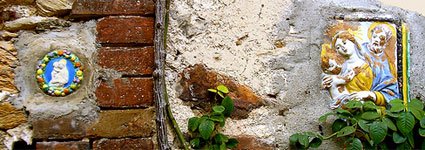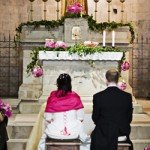This year, it happens that April 1st is also Holy Thursday (Giovedì Santo in Italian), the second important day of Holy Week after Palm Sunday. Christians commemorate the Last Supper of Jesus Christ with the Apostles. The solemn Mass that takes place in the afternoon on Holy Thursday opens the Easter Triduum, the three days that commemorate the Passion, Death and Resurrection of Jesus.
Having grown up in a Catholic family in which my mum and grandmother were real “churchgoers”, while my dad and grandfather were rather “onlookers”, I have developed this “taste” for the ritual aspects of our religion while looking at them with sort of an anthropological eye… I go to church and all, but I cannot help listening to the readings and looking at the rite and trying to find the reasons behind the story that is told and the actions that are re-enacted. I find the whole thing totally fascinating. I am always trying to figure out what principle regulating human society is being “promoted”, if you see what I mean.
I love Easter time. I have so many fond childhood and teenage memories connected with the Easter celebrations. It would all start on the Saturday before Palm Sunday when we, the kids attending “catechismo” (the equivalent of Sunday school, which for us can be any day of the week, and which you attend from when you start school until you are 14 and are confirmed), would be sent out to the farms in the area to collect olive branches for the blessing of the following day.
In such a small village, every kid would participate: we were all altar boys… and girls! It was so much fun!
Then there was the tremendously boring Mass on Palm Sunday, with the reading of the entire Passion of Christ… The only good thing was that, sometimes, we would actually get to read a piece each, and that would keep us awake throughout the service. After the mass, the olive branches would be blessed just outside the church and then Don Piero, the priest we had then, would send us to bring the branches to the people who had not come to church. Well, kids still go door to door today, but it would be inconceivable for the priest today to be able to visit people at home and tell them off for not showing up to church! Can you imagine?! But in a small community of 350 people, back in the 80’s and 90’s that was still perfectly acceptable.
We would go back to our normal life for a couple of days, and then on Wednesday, the Easter holidays would begin: no school for a week!
On Wednesday afternoon, we were sent to summon the 12 men who had been chosen to “play” the 12 Apostles during the Easter Triduum. It was not a fun thing to do, believe me. As usual in Italy, most people say they are catholic, but few are actually practicing Catholics. So when we delivered the news, some would say ok, while others would swear like sailors! Still others would simply find somebody to substitute them (that would be my dad’s case…).
The 12 apostles had to come and pick up their tunic and get ready for the mass of the Holy Thursday, which also includes the ritual washing of feet. On the same day, the women would get together and prepare what is supposed to reproduce the Holy Sepulchre in the smaller chapel in the village. Their job consisted essentially in laying lots of flowers by the altar and making it look pretty. There was an interesting tradition which has now practically disappeared: that of decorating the church with “veccia“. Veccia is vetch in English, I think, but the peculiarity is that, at the beginning of the Lent, seeds were planted in pots then stored away in cellars and other dark rooms. The sprouts grow thin and white (hence the Tuscan saying for sick people “sei bianco come la veccia“, you are as pale as vetch). I think that in my area the seeds planted were actually wheat seeds, rather than vetch. Anyway, my great-grandmother grew lots of pots of these thin, white grass and I had to help her carry them from her cellar to the church.
Right before the Holy Thursday mass, the sacristan (who was really the “director” of this complicated event!) would make the turns for the Easter prayer vigil and would hand them out to the apostles. The Holy Sepulchre is never left unattended, and at least a few people and 2 or more apostles and the priest are always present in the chapel to pray.
Good Friday was my favourite day of the Holy Week. Yes… I know it sounds bad, as it is the day commemorating the crucifixion of Jesus Christ and his death at Calvary. However, it was (and still is) also the day of a procession through the streets of the village for the Stations of the Cross. The Stations of the Cross were prepared in 12 different spots in the village. The local people poured much effort into this task, as the altar for each Station represented the pride and joy of the residents of a part of the village. Nowadays, it’s probably not as important as it used to be, but I remember my great-grandmother, my grandmother and other women living in their building digging out of old and dusty trunks very old ex-voto and decorations, probably handed down from generation to generation. And I remember them hand-embroidering white linens and curtains right before the procession, to decorate their altar.
The Friday afternoon was hectic. The church of Civitella has an old statue of a dead Jesus and a statue of the Virgin Mary. The statue of Jesus was taken out from the glass case under one of the altars of the church where it is normally located and placed on a stand in the middle of the aisle, where caskets are normally placed. The statue of the Virgin was brought from the smaller chapel to the main church and placed on a pageant used to carry it in procession.
The thing I loved the most – and I still wonder where all that stuff is gone – was when we were sent to this room in the sacristy (in which we were normally not allowed) to get the necessary items for the procession. I guess people had accumulated stuff over the centuries really. In a large, worm-eaten, old wardrobe there were soldier costumes, old tunics, ensigns and flags, and the old “Confraternita di Misericordia” flag. The confraternita, literally the brotherhood, is the association that still takes care of the church, the cemetery, the village ambulance etc. I guess in the past, the people in the village had reenacted the whole thing, with period costumes and all.
We would bring these ensigns and the flags to the chapel where they were distributed before the procession, along with candles with colourful paper screens to block the wind.
At 9pm everybody would gather in the main church and the procession of the Stations of the Cross would begin. People would leave the church in a very orderly way. The priest first, followed by the apostles, the statue of Jesus, the men, then 4 young girls carrying the statue of the Virgin Mary and all the women. Such an old tradition. Again, I was fascinated by it. Throughout the village, people would have lit their windows with candles or with lamps. The bars and restaurants would close their windows and turn their TVs and music off. The procession would stop in front of each of the altars with a picture of the episode described in the reading and then we would move on to the next station. People who could not walk up and down the hill would stand by the side of the road, the men with their hats in their hands, the women with their heads covered in black veils and their rosary in their hands. And then, the procession would end in the church and after the blessing, we would all walk up to the statue of the dead Jesus at the front of the church and kiss it.
The procession still happens, but the number of people participating has decreased significantly. I can still smell the candles, and the burning paper around them! So typical!
The Saturday was unusually silent. From the Holy Thursday to the midnight Easter Mass, bells were tied, so there would be no ticking away of the hours, no call to the mass. I would spend the day with my grandmother colouring fresh eggs by boiling them with red onion, or in tea, or just painting them. We would boil enough eggs for the people who were invited to the Easter lunch. The decorated eggs would then be placed in a nice basket, taken to the church and left on one of the side altars.
At 11:00 pm we would go to the church. First the priest would bless the eggs, then the mass would start. After 40 days of no flower decorations anywhere in the church, the main altar was finally covered in beautiful (usually red) flowers.
Above the tabernacle, a red cloth would cover a statue of a resurrected Jesus, which would be uncovered at midnight, when Easter day officially starts. That moment would also be marked by a festive peal of bells, which essentially meant we could go home and open the chocolate eggs to get the surprises!!!
In my village, we still celebrate Easter like that, just in a much more low-keyed way. The numbers of people who go to church is smaller and most people do not really care that much anymore. There are fewer catholic children, and so I guess that the responsibility for most of the chores falls upon the old priest and the “apostles”.
Easter is always a good time of the year to visit smaller places: local communities do their best to make their homes festive and this type of tradition can certainly teach much about the history of a place and about the local (often changing) culture.












[…] This post was mentioned on Twitter by Gloria CasinadiRosa, dreamofitaly. dreamofitaly said: RT @casinadirosa The memories of an Altar Girl! The Holy Week and Easter in a small village in Tuscany http://bit.ly/8Z8sV0 […]
Social comments and analytics for this post…
This post was mentioned on Twitter by casinadirosa: The memories of an Altar Girl! The Holy Week and Easter in a small village in Tuscany http://bit.ly/8Z8sV0 #local #travel #tuscany #easter…